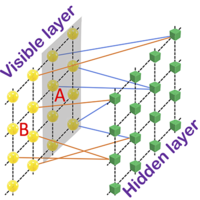Abstract
Machine learning, one of today’s most rapidly growing interdisciplinary fields, promises an unprecedented perspective for solving intricate quantum many-body problems. Understanding the physical aspects of the representative artificial neural-network states has recently become highly desirable in the applications of machine-learning techniques to quantum many-body physics. In this paper, we explore the data structures that encode the physical features in the network states by studying the quantum entanglement properties, with a focus on the restricted-Boltzmann-machine (RBM) architecture. We prove that the entanglement entropy of all short-range RBM states satisfies an area law for arbitrary dimensions and bipartition geometry. For long-range RBM states, we show by using an exact construction that such states could exhibit volume-law entanglement, implying a notable capability of RBM in representing quantum states with massive entanglement. Strikingly, the neural-network representation for these states is remarkably efficient, in the sense that the number of nonzero parameters scales only linearly with the system size. We further examine the entanglement properties of generic RBM states by randomly sampling the weight parameters of the RBM. We find that their averaged entanglement entropy obeys volume-law scaling, and the meantime strongly deviates from the Page entropy of the completely random pure states. We show that their entanglement spectrum has no universal part associated with random matrix theory and bears a Poisson-type level statistics. Using reinforcement learning, we demonstrate that RBM is capable of finding the ground state (with power-law entanglement) of a model Hamiltonian with a long-range interaction. In addition, we show, through a concrete example of the one-dimensional symmetry-protected topological cluster states, that the RBM representation may also be used as a tool to analytically compute the entanglement spectrum. Our results uncover the unparalleled power of artificial neural networks in representing quantum many-body states regardless of how much entanglement they possess, which paves a novel way to bridge computer-science-based machine-learning techniques to outstanding quantum condensed-matter physics problems.
1 More- Received 25 January 2017
DOI:https://doi.org/10.1103/PhysRevX.7.021021
Published by the American Physical Society under the terms of the Creative Commons Attribution 4.0 International license. Further distribution of this work must maintain attribution to the author(s) and the published article’s title, journal citation, and DOI.
Published by the American Physical Society
Physics Subject Headings (PhySH)
Popular Summary
Machine learning gives computers humanlike abilities to interpret concepts through experience. As one of today’s most rapidly growing fields, it plays a central role in artificial intelligence and has the potential to revolutionize modern computer applications such as face recognition, language translation, and self-driving cars. Recently, machine-learning techniques have been introduced to tackle several questions about the behavior of many interacting quantum particles. Success in this context relies vitally on the underlying data structures of the quantum states that are encoded in the artificial neural networks. We explore the data structures of neural-network quantum states by studying their entanglement properties with a focus on a machine-learning model known as the restricted-Boltzmann-machine (RBM) architecture.
Our analysis explores both short- and long-range coupled RBM states. For the former, we prove that the corresponding quantum states have area-law entanglement, independent of spatial dimensionality. For the latter, we find that the long-range RBM could describe volume-law-entangled quantum states efficiently. Through reinforcement learning, we show that RBM can be used to solve a challenging problem of calculating the power-law-entangled ground state for a Hamiltonian with long-range interactions.
Our results reveal some crucial properties of the data structures of neural-network quantum states, which pave a novel way to bridge machine learning and many-body quantum physics. We expect that our findings will spark further exciting progress in the emerging interdisciplinary field of machine-learning quantum phases of matter.



